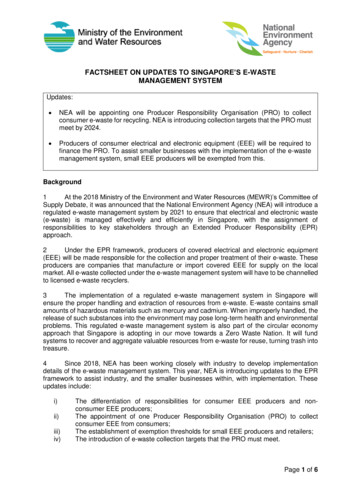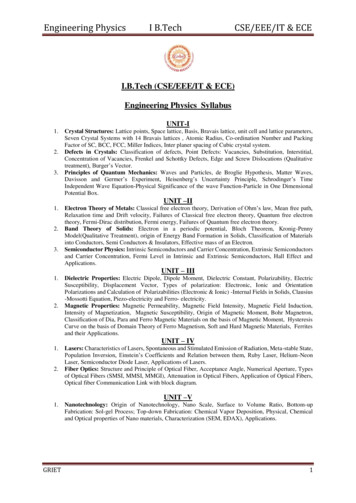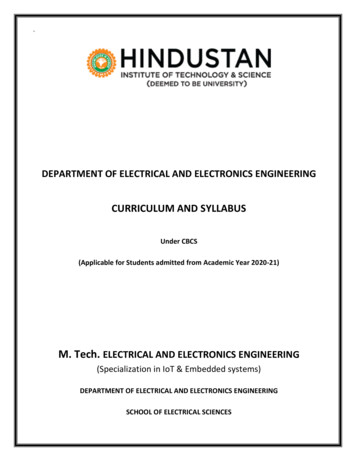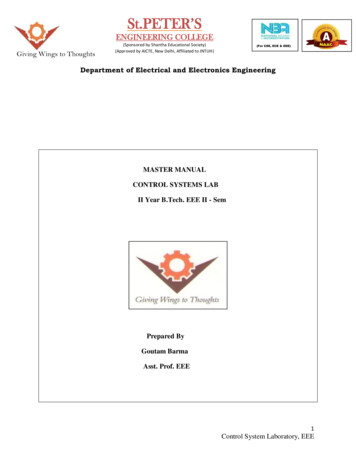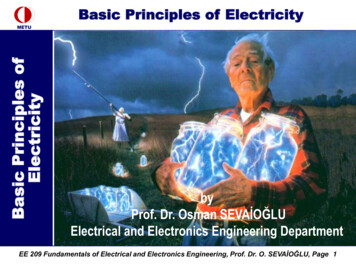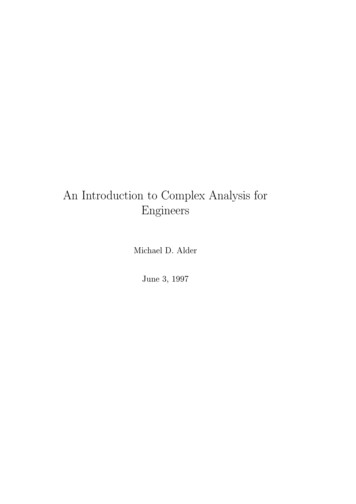
Transcription
An Introduction to Complex Analysis forEngineersMichael D. AlderJune 3, 1997
Preface1These notes are intended to be of use to Third year Electrical and Electronic Engineers at the University of Western Australia coming to grips withComplex Function Theory.There are many text books for just this purpose, and I have insu cient timeto write a text book, so this is not a substitute for, say, Matthews and Howell's Complex Analysis for Mathematics and Engineering,[1], but perhaps acomplement to it. At the same time, knowing how reluctant students are touse a textbook (except as a talisman to ward o evil) I have tried to makethese notes su cient, in that a student who reads them, understands them,and does the exercises in them, will be able to use the concepts and techniques in later years. It will also get the student comfortably through theexamination. The shortness of the course, 20 lectures, for covering ComplexAnalysis, either presupposes genius ( 90% perspiration) on the part of thestudents or material skipped. These notes are intended to ll in some of thegaps that will inevitably occur in lectures. It is a source of some disappointment to me that I can cover so little of what is a beautiful subject, rich inapplications and connections with other areas of mathematics. This is, then,a sort of sampler, and only touches the elements.Styles of Mathematical presentation change over the years, and what wasdeemed acceptable rigour by Euler and Gauss fails to keep modern puristscontent. McLachlan, [2], clearly smarted under the criticisms of his presentation, and he goes to some trouble to explain in later editions that the bookis intended for a di erent audience from the purists who damned him. Myexperience leads me to feel that the need for rigour has been developed tothe point where the intuitive and geometric has been stunted. Both have apart in mathematics, which grows out of the con ict between them. But itseems to me more important to penetrate to the ideas in a sloppy, scru ybut serviceable way, than to reduce a subject to predicate calculus and omitthe whole reason for studying it. There is no known means of persuading ahardheaded engineer that a subject merits his time and energy when it hasbeen turned into an elaborate game. He, or increasingly she, wants to see twoelements at an early stage: procedures for solving problems which make adi erence and concepts which organise the procedures into something intelligible. Carried to excess this leads to avoidance of abstraction and consequent
2loss of power later; there is a good reason for the purist's desire for rigour.But it asks too much of a third year student to focus on the underlying logicand omit the geometry.I have deliberately erred in the opposite direction. It is easy enough for thestudent with a taste for rigour to clarify the ideas by consulting other books,and to wind up as a logician if that is his choice. But it is hard to nd inthe literature any explicit commitment to getting the student to draw lotsof pictures. It used to be taken for granted that a student would do thatsort of thing, but now that the school syllabus has had Euclid expunged, theundergraduates cannot be expected to see drawing pictures or visualising surfaces as a natural prelude to calculation. There is a school of thought whichconsiders geometric visualisation as immoral; and another which sanctions itonly if done in private (and wash your hands before and afterwards). To mymind this imposes sterility, and constitutes an attempt by the bureaucrat tostrangle the artist. 1 While I do not want to impose my informal images onanybody, if no mention is made of informal, intuitive ideas, many studentsnever realise that there are any. All the good mathematicians I know have arich supply of informal models which they use to think about mathematics,and it were as well to show students how this may be done. Since this seemsto be the respect in which most of the text books are weakest, I have perhapsgone too far in the other direction, but then, I do not o er this as a textbook. More of an antidote to some of the others.I have talked to Electrical Engineers about Mathematics teaching, and theyare strikingly consistent in what they want. Prior to talking to them, Ifeared that I'd nd Engineers saying things like Don't bother with the ideas,forget about the pictures, just train them to do the sums'. There are, alas,Mathematicians who are convinced that this is how Engineers see the world,and I had supposed that there might be something in this belief. Silly me.In fact, it is simply quite wrong.The Engineers I spoke to want Mathematicians to get across the abstractideas in terms the students can grasp and use, so that the Engineers cansubsequently rely on the student having those ideas as part of his or herThe bureaucratic temper is attracted to mathematics while still at school, because itappears to be all about following rules, something the bureaucrat cherishes as the solutionto the problems of life. Human beings on the other hand nd this su ciently repellantto be put o mathematics permanently, which is one of the ironies of education. My ownattitude to the bureaucratic temper is rather that of Dave Allen's feelings about politicians.He has a soft spot for them. It's a bog in the West of Ireland.1
3thinking. Above all, they want the students to have clear pictures in theirheads of what is happening in the mathematics. Since this is exactly whatany competent Mathematician also wants his students to have, I haven't feltany need to change my usual style of presentation. This is informal anduser-friendly as far as possible, with (because I am a Topologist by trainingand work with Engineers by choice) a strong geometric avour.I introduce Complex Numbers in a way which was new to me; I point outthat a certain subspace of 2 2 matrices can be identifed with the plane R 2 ,thus giving a simple rule for multiplying two points in R 2 : turn them intomatrices, multiply the matrices, then turn the answer back into a point. Ido it this way because (a) it demysti es the business of imaginary numbers,(b) it gives the Cauchy-Riemann conditions in a conceptually transparentmanner, and (c) it emphasises that multiplication by a complex number is asimilarity together with a rotation, a matter which is at the heart of muchof the applicability of the complex number system. There are a few otheradvantages of this approach, as will be seen later on. After I had done it thisway, Malcolm Hood pointed out to me that Copson, [3], had taken the sameapproach.2Engineering students lead a fairly busy life in general, and the Sparkies havea particularly demanding load. They are also very practical, rightly so, andimpatient of anything which they suspect is academic window-dressing. Sofar, I am with them all the way. They are, however, the main source ofthe belief among some mathematicians that peddling recipes is the only wayto teach them. They do not feel comfortable with abstractions. Their goaltends to be examination passing. So there is some basic opposition betweenthe students and me: I want them to be able to use the material in lateryears, they want to memorise the minimum required to pass the exam (andthen forget it).I exaggerate of course. For reasons owing to geography and history, thisUniversity is particularly fortunate in the quality of its students, and mostof them respond well to the discovery that Mathematics makes sense. I hopethat these notes will turn out to be enjoyable as well as useful, at least inretrospect.But be warned:I am most grateful to Malcolm for running an editorial eye over these notes, but evenmore grateful for being a model of sanity and decency in a world that sometimes seemsbereft of both.2
4 Well of course I didn't do any at rst . then someone suggested I try justa little sum or two, and I thought \Why not? . I can handle it". Thenone day someone said \Hey, man, that's kidstu - try some calculus" . so Itried some di erentials . then I went on to integrals . even the occasionalvolume of revolution . but I can stop any time I want to . I know I can.OK, so I do the odd bit of complex analysis, but only a few times . thatstu can really screw your head up for days . but I can handle it . it's OKreally . I can stop any time I want .' ( tim@bierman.demon.co.uk (TimBierman))
Contents1 Fundamentals91.1 A Little History . . . . . . . . . . . . . . . . . . . . . . . . . .91.2 Why Bother With Complex Numbers and Functions? . . . . . 111.3 What are Complex Numbers? . . . . . . . . . . . . . . . . . . 121.4 Some Soothing Exercises . . . . . . . . . . . . . . . . . . . . . 181.5 Some Classical Jargon . . . . . . . . . . . . . . . . . . . . . . 221.6 The Geometry of Complex Numbers . . . . . . . . . . . . . . 261.7 Conclusions . . . . . . . . . . . . . . . . . . . . . . . . . . . . 292 Examples of Complex Functions332.1 A Linear Map . . . . . . . . . . . . . . . . . . . . . . . . . . . 342.2 The function w z2 . . . . . . . . . . . . . . . . . . . . . . . 362.3 The Square Root: w z 21 . . . . . . . . . . . . . . . . . . . . 462.3.1 Branch Cuts . . . . . . . . . . . . . . . . . . . . . . . . 492.3.2 Digression: Sliders . . . . . . . . . . . . . . . . . . . . 512.4 Squares and Square roots: Summary . . . . . . . . . . . . . . 582.5 The function f (z) z1. . . . . . . . . . . . . . . . . . . . . 585
CONTENTS62.6 The M obius Transforms . . . . . . . . . . . . . . . . . . . . . 662.7 The Exponential Function . . . . . . . . . . . . . . . . . . . . 692.7.1 Digression: In nite Series . . . . . . . . . . . . . . . . 702.7.2 Back to Real exp . . . . . . . . . . . . . . . . . . . . . 732.7.3 Back to Complex exp and Complex ln . . . . . . . . . 762.8 Other powers . . . . . . . . . . . . . . . . . . . . . . . . . . . 812.9 Trigonometric Functions . . . . . . . . . . . . . . . . . . . . . 823 C - Di erentiable Functions893.1 Two sorts of Di erentiability . . . . . . . . . . . . . . . . . . . 893.2 Harmonic Functions . . . . . . . . . . . . . . . . . . . . . . . 973.2.1 Applications . . . . . . . . . . . . . . . . . . . . . . . . 1003.3 Conformal Maps . . . . . . . . . . . . . . . . . . . . . . . . . 1024 Integration1054.1 Discussion . . . . . . . . . . . . . . . . . . . . . . . . . . . . . 1054.2 The Complex Integral . . . . . . . . . . . . . . . . . . . . . . 1074.3 Contour Integration . . . . . . . . . . . . . . . . . . . . . . . . 1134.4 Some Inequalities . . . . . . . . . . . . . . . . . . . . . . . . . 1194.5 Some Solid and Useful Theorems . . . . . . . . . . . . . . . . 1205 Taylor and Laurent Series1315.1 Fundamentals . . . . . . . . . . . . . . . . . . . . . . . . . . . 1315.2 Taylor Series . . . . . . . . . . . . . . . . . . . . . . . . . . . . 134
CONTENTS75.3 Laurent Series . . . . . . . . . . . . . . . . . . . . . . . . . . . 1385.4 Some Sums . . . . . . . . . . . . . . . . . . . . . . . . . . . . 1405.5 Poles and Zeros . . . . . . . . . . . . . . . . . . . . . . . . . . 1436 Residues1496.1 Trigonometric Integrals . . . . . . . . . . . . . . . . . . . . . . 1536.2 In nite Integrals of rational functions . . . . . . . . . . . . . . 1546.3 Trigonometric and Polynomial functions . . . . . . . . . . . . 1596.4 Poles on the Real Axis . . . . . . . . . . . . . . . . . . . . . . 1616.5 More Complicated Functions . . . . . . . . . . . . . . . . . . . 1646.6 The Argument Principle; Rouch e's Theorem . . . . . . . . . . 1686.7 Concluding Remarks . . . . . . . . . . . . . . . . . . . . . . . 174
8CONTENTS
Chapter 1Fundamentals1.1 A Little HistoryIf Complex Numbers had been invented thirty years ago instead of overthree hundred, they wouldn't have been called Complex Numbers' at all.They'd have been called Planar Numbers', or Two-dimensional Numbers'or something similar, and there would have been none of this nonsense about imaginary' numbers. The square root of negative one is no more and no lessimaginary than the square root of two. Or two itself, for that matter. All ofthem are just bits of language used for various purposes. Two' was invented for counting sheep. All the positive integers (whole numbers) were invented so we could count things, and that's all they were invented for. The negative integers were introduced so it would be easy tocount money when you owed more than you had.The rational numbers were invented for measuring lengths. Since we cantransduce things like voltages and times to lengths, we can measure otherthings using the rational numbers, too.The Real numbers were invented for wholly mathematical reasons: it wasfound that there were lengths such as the diagonal of the unit square which,in principle, couldn't be measured by the rational numbers. This is of notthe slightest practical importance, because in real life you can measure onlyto some limited precision, but some people like their ideas to be clean andcool, so they went o and invented the real numbers, which included the9
CHAPTER 1. FUNDAMENTALS10rationals but also lled in the holes. So practical people just went on doingwhat they'd always done, but Pure Mathematicians felt better about themdoing it. Daft, you might say, but let us be tolerant.This has been put in the form of a story:A (male) Mathematician and a (male) Engineer who knew each other, hadboth been invited to the same party. They were standing at one corner of theroom and eyeing a particularly attractive girl in the opposite corner. Wow,she looks pretty good,' said the Engineer. I think I'll go over there and trymy luck.' Impossible, and out of the question!' said the Mathematician, who wasthinking much the same but wasn't as forthright. And why is it impossible?' asked the Engineer belligerently. Because,' said the Mathematician, thinking quickly, In order to get to her,you will rst have to get halfway. And then you will have to get half of therest of the distance, and then half of that. And so on; in short, you can neverget there in a nite number of moves.'The Engineer gave a cheerful grin. Maybe so,' he replied, But in a nite number of moves, I can get as closeas I need to be for all practical purposes.'And he made his moves.***The Complex Numbers were invented for purely mathematical reasons, justlike the Reals, and were intended to make things neat and tidy in solvingequations. They were regarded with deep suspicion by the more conservativefolk for a century or so.It turns out that they are very cool things to have for measuring' such thingsas periodic waveforms. Also, the functions which arise between them are veryuseful for talking about solutions of some Partial Di erential Equations. Sodon't look down on Pure Mathematicians for wanting to have things cleanand cool. It pays o in very unexpected ways. The Universe also seemsto like things clean and cool. And most supersmart people, such as Gauss,like nding out about Electricity and Magnetism, working out how to handle
1.2. WHY BOTHER WITH COMPLEX NUMBERS AND FUNCTIONS?11calculations of orbits of asteroids and doing Pure Mathematics.In these notes, I am going to rewrite history and give you the story aboutComplex Numbers and Functions as if they had been developed for the applications we now know they have. This will short-circuit some of the mystery,but will be regarded as shocking by the more conservative. The same sort ofperson who three hundred years ago wanted to ban them, is now trying tokeep the confusion. It's a funny old world, and no mistake.Your text books often have an introductory chapter explaining a bit of thehistorical development, and you should read this in order to be educated,but it isn't in the exam.1.2 Why Bother With Complex Numbers andFunctions?In mastering the material in this book, you are going to have to do a lot ofwork. This will consist mainly of chewing a pencil or pen as you struggle todo some sums. Maths is like that. Hours of your life will pass doing this,when you could be watching the X- les or playing basketball, or whatever.There had better be some point to this, right?There is, but it isn't altogether easy to tell you exactly what it is, becauseyou can only really see the advantages in hindsight. You are probably quiteglad now that you learnt to read when you were small, but it might haveseemed a drag at the time. Trust me. It will all be worth it in the end.If this doesn't altogether convince you, then talk to the Engineering Lecturers about what happens in their courses. Generally, the more modernand intricate the material, the more Mathematics it uses. CommunicationEngineering and Power Transmission both use Complex Functions; FilteringTheory in particular needs it. Control Theory uses the subject extensively.Whatever you think about Mathematicians, your lecturers in Engineeringare practical people who wouldn't have you do this course if they thoughtthey could use the time for teaching you more important things.Another reason for doing it is that it is fun. You may nd this hard to believe,but solving problems is like doing exercise. It keeps you t and healthy andhas its own satisfactions. I mean, on the face of it, someone who runs three
CHAPTER 1. FUNDAMENTALS12kilometres every morning has to be potty: they could get there faster in acar, right? But some people do it and feel good about themselves becausethey've done it. Well, what works for your heart and lungs also applies toyour brain. Exercising it will make you feel better. And Complex Analysis isone of the tougher and meatier bits of Mathematics. Tough minded peopleusually like it. But like physical exercise, it hurts the rst time you do it,and to get the bene ts you have to keep at it for a while.I don't expect you to buy the last argument very easily. You're kept busywith the engineering courses which are much more obviously relevant, andI'm aware of the pressure you are under. Your main concern is making sureyou pass the examination. So I am deliberately keeping the core materialminimal.I am going to start o by assuming that you have never seen any complexnumbers in your life. In order to explain what they are I am going to do abit of very easy linear algebra. The reasons for this will become clear fairlyquickly.1.3 What are Complex Numbers?Complex numbers are points in the plane, together with a rule telling youhow to multiply them. They are two-dimensional, whereas the Real numbersare one dimensional, they form a line. The fact that complex numbers forma plane is probably the most important thing to know about them.Remember from rst year that 2 2 matrices transform points in the plane.To be de nite, take xyfor a point, or if you prefer vector in R 2 and let a cb d be a 2 2 matrix. Placing the matrix to the left of the vector: a cb d xy
1.3. WHAT ARE COMPLEX NUMBERS?13and doing matrix multiplication gives a new vector: ax cybx dyThis is all old stu which you ought to be good at by now1 .Now I am going to look at a subset of the whole collection of 2 2 matrices:those of the form a bb afor any real numbers a; b.The following remarks should be carefully checked out: These matrices form a linear subspace of the four dimensional space ofall 2 2 matrices. If you add two such matrices, the result still has the same form, the zero matrix is in the collection, and if you multiply anymatrix by a real number, you get another matrix in the set.These matrices are also closed under multiplication: If you multiplyany two such matrices, say a b and c db ad cthen the resulting matrix is still antisymmetric and has the top leftentry equal to the bottom right entry, which puts it in our set.The identity matrix is in the set.Every such matrix has an inverse except when both a and b are zero,and the inverse is also in the set.The matrices in the set commute under multiplication. It doesn't matter which order you multiply them in.All the rotation matrices: cos sin sin cos are in the set.If you are not very con dent about this, (a) admit it to yourself and (b) dig out someold Linear Algebra books and practise a bit.1
CHAPTER 1. FUNDAMENTALS14 The columns of any matrix in the set are orthogonal This subset of all 2 2 matrices is two dimensional.Exercise 1.3.1 Before going any further, go through every item on this listand check out that it is correct. This is important, because you are going tohave to know every one of them, and verifying them is or ought to be easy.This particular collection of matrices IS the set of Complex Numbers. I de nethe complex numbers this way:De nition 1.3.1 C is the name of the two dimensional subspace of the fourdimensional space of 2 2 matrices having entries of the form abfor any real numbers a; b. Points ofcomplex numbers.ba Care called, for historical reasons,There is nothing mysterious or mystical about them, they behave in a thoroughly straightforward manner, and all the properties of any other complexnumbers you might have come across are all properties of my complex numbers, too.You might be feeling pslightly gobsmacked by this; where are all the imaginarynumbers? Where is 1? Have patience. We shall now gradually recoverall the usual hocus-pocus.First, the fact that the set of matrices is a two dimensional vector spacemeans that we can treat it as if it were R 2 for many purposes. To nail thisidea down, de ne:C : R2 ! Cby a ; a bbb aThis sets up a one to one correspondence between the points of the planeand the matrices in C . It is easy to check out:
1.3. WHAT ARE COMPLEX NUMBERS?15Proposition 1.3.1 C is a linear mapIt is clearly onto, one-one and an isomorphism. What this means is that thereis no di erence between the two objects as far as the linear space propertiesare concerned. Or to put it in an intuitive and dramatic manner:You can aathink of points in the plane b or you can think of matrices b ab andit makes no practical di erence which you choose- at least as far as adding,subtracting or scaling them is concerned. To drive this point home, if youchoose the vector representation for a couple of points, and I translate theminto matrix notation, and if you add your vectors and I add my matrices,then your result translates to mine. Likewise if we take 3 times the rst andadd it to 34 times the second, it won't make a blind bit of di erence if youdo it with vectors or I do it with matrices, so long as we stick to the sametranslation rules. This is the force of the term isomorphism, which is derivedfrom a Greek word meaning the same shape'. To say that two things areisomorphic is to say that they are basically the same, only the names haveabeen changed. If you think of a vector b as being a name' of a point ab2in R , and a two by two matrix b a as being just a di erent namefor the same point, you will have understood the very important idea of anisomorphism.You might have an emotional attachment to one of these ways of representingpoints in R 2 , but that is your problem. It won't actually matter which youchoose.Of course, the matrix form uses up twice as much ink and space, so you'd bea bit weird to prefer the matrix form, but as far as the sums are concerned,it doesn't make any di erence.Except that you can multiply the matrices as well as add and subtract andscale them.And what THIS means is that we have a way of multiplying points of R 2 . Given the points ab and dc in R 2 , I decide that I prefer to think of abcdthem as matrices b a and d c , then I multiply these together
CHAPTER 1. FUNDAMENTALS16to get (check this on a piece of paper) ac bdad bc(ad bc)ac bd Now, if you have a preference for the more compressed form, you can't multiply your vectors, Or can you? Well, all you have to do is to translate yourvectors into my matrices, multiply them and change them back to vectors.Alternatively, you can work out what the rules are once and store them in asafe place: a c ac bdbdad bc Exercise 1.3.2 Work through this carefully by translating the vectors intomatrices then multiply the matrices, then translate back to vectors.Now there are lots of ways of multiplying points of R 2 , but this particularway is very cool and does some nice things. It isn't the most obvious wayfor multiplying points of the plane, but it is a zillion times as useful as theothers. The rest of this book after this chapter will try to sell that idea.First however, for those who are still worried sick that this seems to havenothing to do with (a ib), we need to invent a more compressed notation.I de ne: De nition 1.3.2 For all a; b 2 R; a ib abba So you now have three choices.1. You can write a ib for a complex number; a is called the real part andb is called the imaginary part. This is just ancient history and faintlyweird. I shall call this the classical representation of a complex number.The i is not a number, it is a sort of tag to keep the two components(a,b) separated.
1.3. WHAT ARE COMPLEX NUMBERS? 17 2. You can write ab for a complex number. I shall call this the pointrepresentation of a complex number. It emphasises the fact that thecomplex numbers form a plane.3. You can write a bb afor the complex number. I shall call this the matrix representation forthe complex number.If we go the rst route, then in order to get the right answer when we multiply(a ib) (c id) ((ac bd) i(bc ad))(which has to be the right answer from doing the sum with matrices) we cansort of pretend that i is a number but that i2 1. I suggest that you mightfeel better about this if you think of the matrix representation as the basicone, and the other two as shorthand versions of it designed to save ink andspace.Exercise 1.3.3 Translate the complex numbers (a ib) and (c id) into ma-trix form, multiply them out and translate the answer back into the classicalform.Now pretend that i is just an ordinary number with the property that i2 1.Multiply out (a ib) (c id) as if everything is an ordinary real number,put i2 1, and collect up the real and imaginary parts, now using the i asa tag. Verify that you get the same answer.This certainly is one way to do things, and indeed it is traditional. But itrequires the student to tell himself or herself that there is something deeplymysterious going on, and it is better not to ask too many questions. Actually,all that is going on is muddle and confusion, which is never a good idea unlessyou are a politician.The only thing that can be said about these three notations is that they eachhave their own place in the scheme of things.The rst, (a ib), is useful when reading old fashioned books. It has theadvantage of using least ink and taking up least space. Another advantage
18CHAPTER 1. FUNDAMENTALSis that it is easy to remember the rule for multiplying the points: you justcarry on as if they were real numbers and remember that i2 1. It has thedisadvantage that it leaves you with a feeling that something inscrutable isgoing on, which is not the case.The second is useful when looking at the geometry of complex numbers,something we shall do a lot. The way in which some of them are close toothers, and how they move under transformations or maps, is best done bythinking of points in the plane.The third is helpful when thinking about the multiplication aspects of complex numbers. Matrix multiplication is something you should be quite comfortable with.Which is the right way to think of complex numbers? The answer is: Allof the above, simultaneously. To focus on the geometry and ignore thealgebra is a blunder, to focus on the algebra and forget the geometry is aneven bigger blunder. To use a compact notation but to forget what it meansis a sure way to disaster.If you can be able to ip between all three ways of looking at the complexnumbers and choose whichever is easiest and most helpful, then the subjectis complicated but fairly easy. Try to nd the one true way and cling to itand you will get marmelised. Which is most uncomfortable.1.4 Some Soothing ExercisesYou will probably be feeling a bit gobsmacked still. This is quite normal,and is cured by the following procedure: Do the next lot of exercises slowlyand carefully. Afterwards, you will see that everything I have said so far isdead obvious and you will wonder why it took so long to say it. If, on theother hand you decide to skip them in the hope that light will dawn at alater stage, you risk getting more and more muddled about the subject. Thiswould be a pity, because it is really rather neat.There is a good chance you will try to convince yourself that it will be enoughto put o doing these exercises until about a week before the exam. Thiswill mean that you will not know what is going on for the rest of the course,but will spend the lectures copying down the notes with your brain out of
1.4. SOME SOOTHING EXERCISES19gear. You won't enjoy this, you really won't.So sober up, get yourself a pile of scrap paper and a pen, put a chair somewhere quiet and make sure the distractions are somewhere else. Some peopleare too dumb to see where their best interests lie, but you are smarter thanthat. Right?Exercise 1.4.1 Translate the complex numbers (1 i0), (0 i1), (3-i2) intothe other two forms. The rst is often written 1, the second as i. Exercise 1.4.2 Translate the complex numbers 20 02 ; 21and 1 2 into the other two forms. 0 1 ; 01 01Exercise 1.4.3 Multiply the complex number 01 by itself. Express in all three forms.Exercise 1.4.4 Multiply the complex numbersNow do it for 23 ab andand 23 ab Translate this into the (a ib) notation.Exercise 1.4.5 It is usual to de ne the norm of a point as its distance fromthe origin. The convention is to writepk ab k a2 b2 1 ;0
CHAPTER 1. FUNDAMENTALS20In the classical notation, we call it the modulus and writepja ibj a2 b2There is not the slightest reason to have two di erent names except that thisis what we have always done.Find a description of the complex numbers of modulus 1 in th
Alder June 3, 1997. 1 Preface These notes are in tended to be of use Third y ear Electrical and Elec-tronic Engineers at the Univ ersit yof W estern Australia coming to grips with Complex F unction Theory. There are man y text b o oks for just this purp ose, and I ha v e insu cien t time
